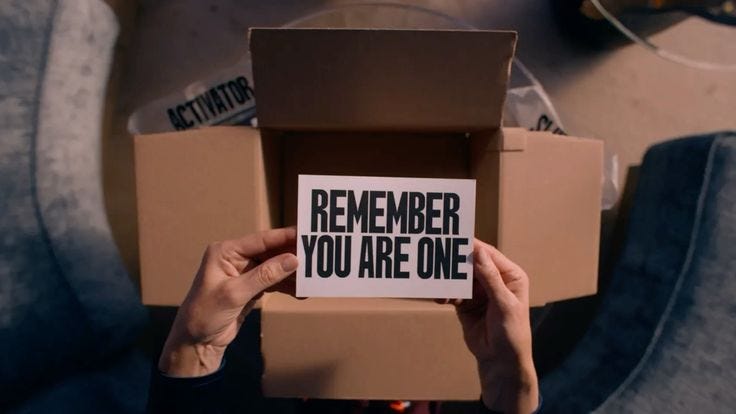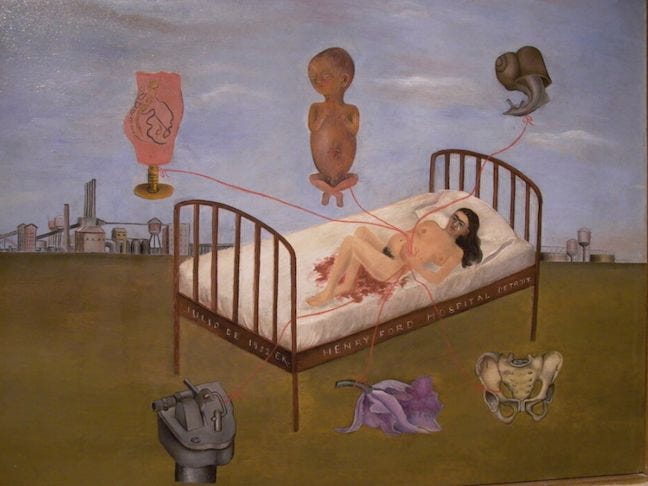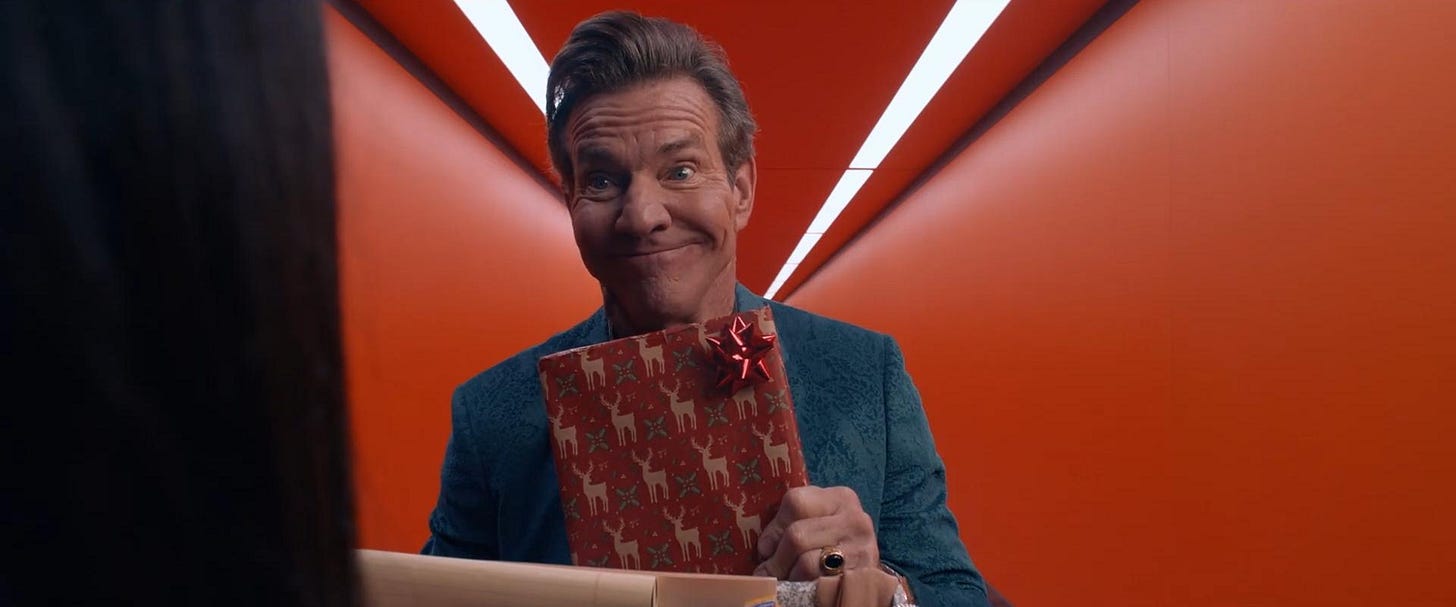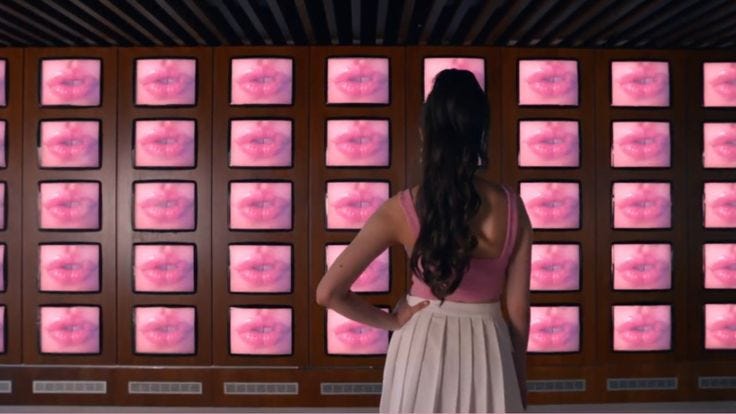Blood, Sweat, Tears, and More Blood: What "The Substance" Gets Right About Female Bodies and Pain
I finally watched "The Substance" and here are my thoughts
“Women are born with pain built in. It’s our physical destiny: period pains, sore boobs, childbirth, you know. We carry it within ourselves throughout our lives…We have it all going on in here inside, we have pain on a cycle for years and years and years and then just when you feel you are making peace with it all, what happens? The menopause comes, the f*cking menopause comes, and it is the most wonderful f*cking thing in the world. And yes, your entire pelvic floor crumbles and you get f*cking hot and no one cares, but then you’re free, no longer a slave, no longer a machine with parts. You’re just a person.”
- Kristin Scott Thomas in Fleabag Season 2, Episode 3
This past week, I was on the second week of my birth control pill pack. My hair constantly felt (and sometimes looked) like it needed to be washed even after I had just washed it. My skin broke out and the few, large pimples I had hurt to the touch. My breasts were incredibly sore and my body felt like it needed to be wrung out like a washcloth. This is a normal occurrence every month.
The amount of times that my personal womanhood has felt “gross” is innumerable. That, in its own way, is normal; every woman has to go through period pains, hair and skin changes, secretion of discharge, blood, and other bodily fluids. All of these painful, smelly, oftentimes objectively “gross” things are part of every woman’s experience, and yet we are expected to have shiny, healthy hair, bright teeth, smooth skin, and bodies that are hairless, shaped a certain way, and constantly smell good. It’s an odd tightrope walk of allowing your body to exist naturally, but trying to define what “natural” is in a world where women’s bodies and faces are oftentimes presented as curved, flat-stomached, red-lipped, and conventionally beautiful. It’s like how the joke in the TV show The Marvelous Mrs. Maisel is that she’d do her hair and makeup every morning before her husband woke up, because her full lashes and rosy cheeks are what he practically considered “natural” and “bare faced.”
That’s what Coralie Fargeat’s incredible and insane new body horror flick The Substance gets right. Women’s bodies can be beautiful, gross, interesting, and weird. And everyone will always have a comment about it, no matter what you do.
**Full spoilers ahead if you haven’t seen this film**
A Quick Synopsis
The movie introduces us to Elisabeth Sparkle (Demi Moore), an aerobics instructor turned celebrity who has a daytime show and a star on Hollywood Boulevard. She’s incredibly successful, and yet on her fiftieth birthday, her boss (Dennis Quaid) fires her, telling her it’s time to find someone younger to take her place on the show.
Soon after being let go, she learns about an underground drug called “The Substance” which creates a younger and supposedly “better” version of yourself. When injected, you essentially birth a younger version of you, and the two selves alternate every week. One version of you lives out the week, while the other exists in a comatose state, sustained by an IV provided by the company behind the drug. The one thing to remember while taking the Substance is that there is no separation concerning the two bodies. They are still one person.
Elisabeth’s younger self, who names herself Sue (Margaret Qualley), auditions for the aerobics vacancy and ends up landing the job. The only problem is, she enjoys her growing popularity a little too much, and starts breaking the “one week on, one week off” rule, resulting in Elisabeth’s body aging rapidly without her consent. The two begin to resent each other, seeing themselves as separate beings rather than one entity. When Elisabeth finally returns to her body after weeks of Sue continually abusing her time as the younger self, she is incredibly old-looking, to the point where she doesn’t look like herself anymore. She regrets that she started the process in the first place and calls the company to ask for a way to terminate Sue.
Furious that Elisabeth tried to end her existence, Sue attacks her in a fit of rage, ultimately killing her. But, as the rules dictate, since they are one and the same, Sue cannot survive without Elisabeth. Desperate to save herself before her big New Year’s Eve show for the network that evening, Sue uses the last of the Substance fluid in an attempt to create a new version of herself. What emerges is a combination of Elisabeth and Sue with arms sticking out in odd places and facial features misplaced, almost like a Picasso. She attempts to do the New Year’s Eve show as this “Elisasue” but the audience is horrified by her and attacks her, thinking that she’s a monster. The film’s final moments show her dragging herself out of the studio, a bloody wreck, as she dies on her Hollywood star. The last shot of the film is a street cleaner slowly clearing away the blood on the star as if nothing happened.
Female Bodies and Body Horror: A History
Body horror as a genre was first labeled in films, but has been around since Mary Shelley wrote Frankenstein. It’s a genre that fascinates me because of its inherent weirdness, and I love exploring how the genre treats the female body, an entity that is often unpredictable. The genre often explores how something you feel you have control over, like your body and its functions, can suddenly be out of control, whether that be because of disease, possession, science fiction mutations (think The Fly) or even things growing inside of you fighting for a way out (much like that famous scene from Alien).
There are many aspects of body horror as a genre that reference the female experience. Sure, many of us women and femmes aren’t levitating off our beds while being exorcised like Regan MacNeil (at least, I hope not), but many of us can probably remember the first time we went to the bathroom for a quick pee only to see the toilet bowl full of blood. Many of us may have experienced or will experience what it’s like for a child to grow inside of us and then push their way out in pregnancy, or be told that we must be cut open in order for the baby to come out via C-section. Cramps in the lower belly, lower back, and even thighs and legs during menstruation can cause girls, women, and femmes to miss school or social activities because they are unable to get out of bed.
That is often why female bodies or female experiences like pregnancy are at the center of horror films or horror genres. Female bodies have an unpredictability about them that can turn on a coin against their owner, much like a jump scare or plot twist. It is an object to fear, and that, in many ways is its super power. When women and femmes harness that pain, that’s what makes them strong.
The Message of The Film
I, like many others, was shocked at how bonkers this movie was. The cinematography, the directing, the special effects, the acting; it was all incredible and it deserves every award it’s getting. But apart from the actual construction of the film, what struck me most was its subject matter and how it handled it.
There was a movie that came out in the summer of 2023 that took the world by storm and had everyone wearing pink. Remember that? Remember how you couldn’t escape from hearing Billie Eilish singing “when did it end?” without wanting to cry? Yeah, I remember Barbie summer too. Greta Gerwig’s Barbie was great for many reasons but most of all because of how much you could unpack from it. I remember my parents saying after they’d first watched it that you could easily write a thesis on any part of the movie because of how intricate it was in displaying the complexities of womanhood.
That’s what’s great about The Substance, but in a completely different way. Barbie illustrated how wonderful and beautiful womanhood is. The Substance highlights the dark underbelly, shining an unflinching light on the things that can make womanhood hell. And it’s all the better for doing so.
At its core, The Substance centers on the complicated and painful relationship we have with ourselves, particularly in the face of self-loathing and societal pressures. The film explores how self-worth is shaped by internal struggles and external expectations, and how, despite our best efforts, we can never fully escape judgment, most especially the judgement that we give ourselves. That is something that not only many people can relate to, but most especially women and femmes who are often scrutinized daily and can be their own worst enemies.
Despite its campiness and craziness, the film has some moments that made me emotional. First and foremost, the movie is riddled with moments of insecurity. Some perfect examples of this are Elisabeth worrying about her aged finger, or Sue being concerned if people saw the chicken leg poking out of her skin. Both are illustrations of how insecurities often manifest in ways that are exaggerated in our minds, and how the things we fear others will notice are often invisible to those around us.
But one of the most heartbreaking moments in the film was watching Elisabeth plead with Sue when she almost terminates her, saying, “I need you” because of how much she hates herself. All I wanted to do in that moment was give her a hug. Her confession was uncomfortably relatable in the way she only feels valued because of validation from others. In a man’s world, validation is the highest form of honor, and for someone like Elisabeth whose identity is synonymous with her role as a celebrity of sorts, her self-worth relies on people seeing her, watching her, and being interested in how she looks.
Now, don’t get me wrong, the campiness was one of the best aspects of the film. Every exaggerated performance by the men in this movie was peak humor, and I couldn’t help but laugh. I remember my friends saying, “why are you laughing?” when Dennis Quaid’s face would be way too close to the camera or when the neighbor across the hall mispronounced his own name because he was ogling Sue. Even Quaid’s delivery of lines like, “oh, I love my wife!” made me die. These men are purposefully portrayed as comically bad with their game show host-esque suits and insincerity. And of course Quaid’s character’s name is Harvey. His name alone is so on the nose. His role as an executive emphasizes the film’s critique of the faceless forces that dictate how people, particularly women, should look and behave. (And I would just like to say as a diehard fan of The Parent Trap I was like, ‘Nick Parker what are you doing?! Get back to the vineyard NOW!’)
The biggest moment of the film that really got me was the end when Sue feels she needs a better version of herself, and she’s already the better version. When she uses the last of the drug which results in the “Elisasue” concoction, she looks nothing like herself anymore, and I wanted her to succeed anyway. It hurt my heart terribly when everyone in the audience of the New Year’s Eve show began to point and scream at her, yelling “monster!” and wanting to kill her. The most chilling part to me that made me feel the most terrible was that she was trying to tell people, “it’s me!” Despite everything, despite all her use and misuse of the drug, who she was truly was on the inside. She only wanted people to see it.
It made me think of women who have things done to their face like plastic surgery or lip filler. They do it to feel better about themselves, to look younger, what have you, and no matter what choices they make with their bodies they will still be vilified and judged, and no one will take the time to focus on the inner beauty, their inner self, no matter what’s happening on the outside. Quite honestly, I think the ending would have still gone the same way no matter what she looked like. The audience wouldn’t have wanted the original version of her because she’s considered too old. They would have been horrified by Sue as she deteriorated and lost things like her teeth and nails rapidly, and they (obviously) hated Elisasue. It goes to show that no matter what you do, everyone’s going to have a comment about how you look.
Battling Critiques
Now, I have seen some critiques about Elisabeth’s aged body being used for horror purposes, and how it’s almost “ageist.” I can see why they would take that approach, but I thought of it quite differently.
Her haggard appearance is not a true representation of aging, but a manifestation of her deepest fear: losing her beauty and relevance. It serves as a visual metaphor for the devastating consequences of her reliance on the drug and her internalized anxieties about time slipping away from her. The film does not condemn aging, but rather uses this exaggerated transformation to show the destructive power of fear and self-loathing. Elisabeth’s body is not a villain; it is a reflection of the fears she carried with her all along, and it would never have come to be had she not sought to alter herself in the first place.
In the behind the scenes, director Coralie Fargeat described how as a woman nearing fifty herself, she feels like it’s almost an expiration date in the entertainment industry. There is a perception that there is always going to be a person who is younger and better for the job. This project for herself was a metaphorical roundhouse kick in the face of that idea; it was her way of proving that aging isn’t something to fear or resent, but rather to accept and blossom into. This is one of Fargeat’s only feature length films, having directed two before this. She’s almost fifty, but she isn’t slowing down any time soon, especially after the success this film has garnered. I’m so excited to see what she does next.
How I Navigate the World After Seeing Something Like “The Substance”
I don’t know about you all, but I’m the type of person who is genuinely changed after seeing a movie. I’m always such a different person once I finish a film. When I finished The Substance, I remember thinking, “I don’t want to watch this ever again!” I know I’m lying to myself and will probably watch it again in the future, but it was a lot to digest in the moment. A lot of it was incredibly gross and disturbing. But…that’s kind of the point.
In many ways, The Substance reflects the idea that “what you put in yourself is what you get out.” Elisabeth’s decision to take the drug, in an attempt to preserve her beauty, results in the cultivation of insecurity and self-hatred. It is a manifestation of the fear of aging and the relentless pressure to maintain youthfulness at any cost. The film poignantly illustrates that self-loathing, when nurtured, will grow and fester, ultimately impacting not only the body but also the mind and soul.
When I left Barbie after watching it in theaters in 2023, I remember thinking about wanting to foster my femininity, something I never outwardly celebrated often. I wanted to nurture my female friendships and strengthen relationships with all the women in my family. It made me feel excited and happy about my womanhood.
When I finished The Substance, I didn’t feel disgusted by it or hopeless about womanhood. It made me have such a deep empathy for myself. All I wanted to do was nurture and foster my relationship with myself. I suddenly wanted to take immense care of myself. I wanted to celebrate all the things that conventional beauty standards don’t, like the cellulite on my thighs or my deep smile lines that will grow deeper as I age. This movie was a reminder to me that every age is beautiful. Yes, it’s important to treat others well, but how can we do that if we don’t treat ourselves in the same way?
Girlhood and womanhood is weird and gross and interesting. The journey of growing into your body can be strange, unsettling, and captivating. Yet, within all that weirdness lies something profoundly interesting: the way women embrace these contradictions, shaping themselves with resilience, creativity, and strength. The grossness often comes from the messy realities of living in a world that isn’t always kind or understanding, but the beauty is in how women persist, challenge, and redefine what it means to be a girl or a woman. It’s in the contradictions themselves that the richness of the experience unfolds.
And that’s the true horror of The Substance. Because no matter what we do or how we look, we’re still going to be judged. But the moment we stop letting that affect us is when we really win.
Happy February, everyone! In a month that prioritizes love with things like Valentine’s Day, remember to put yourself at the center and that the best relationship you can ever have with anyone is yourself.
- Lillian











Now THIS is what movie reviews should be!!!!! Bravo, this was absolutely incredible and made me see the movie in a whole new light. I agree with Ryan, this was a perfect recap and explanation of the film!!!!
What an amazing and heartfelt review. I can admit that the gore really got me, but the message was still so prevalent and important. This was a perfect recap and explanation of this film.